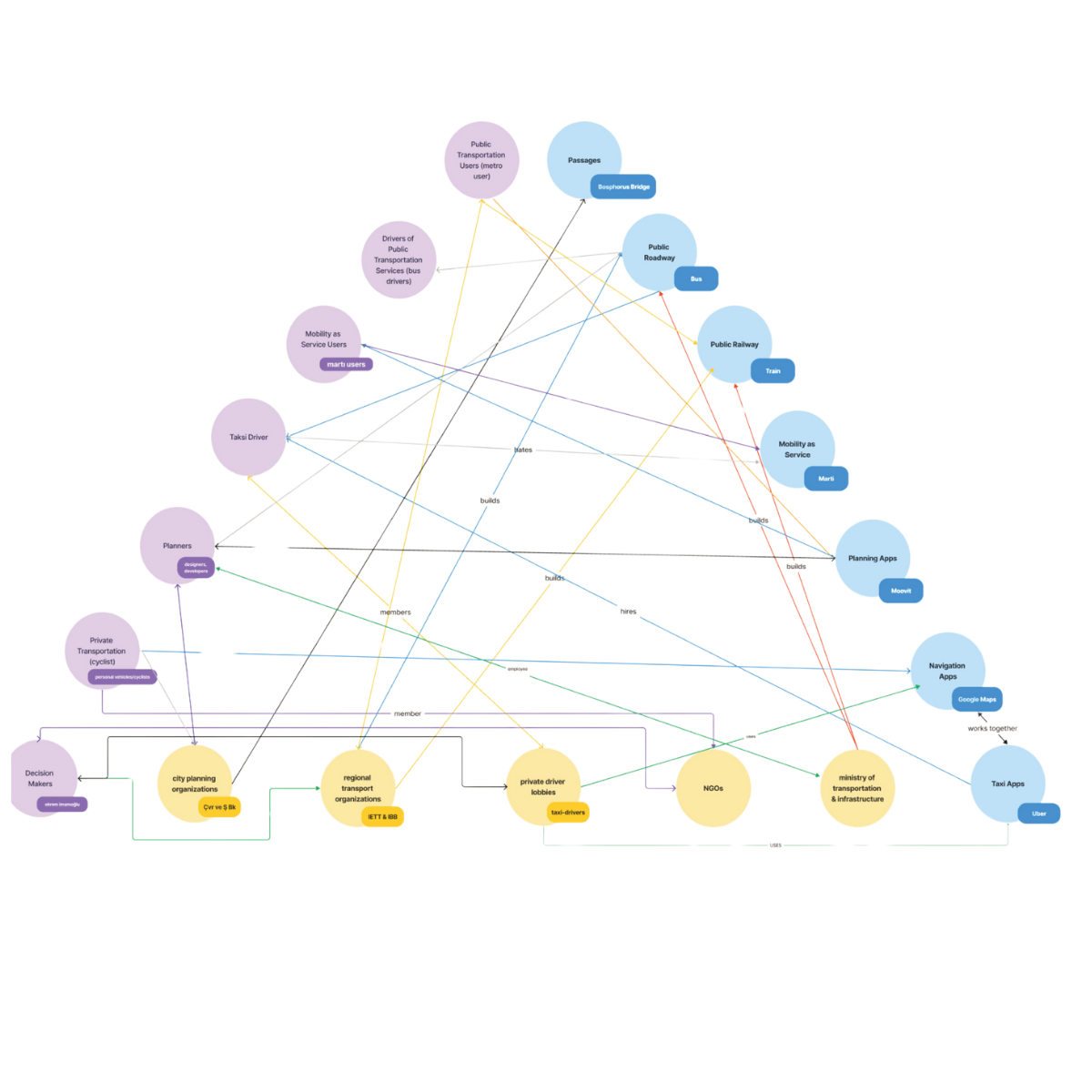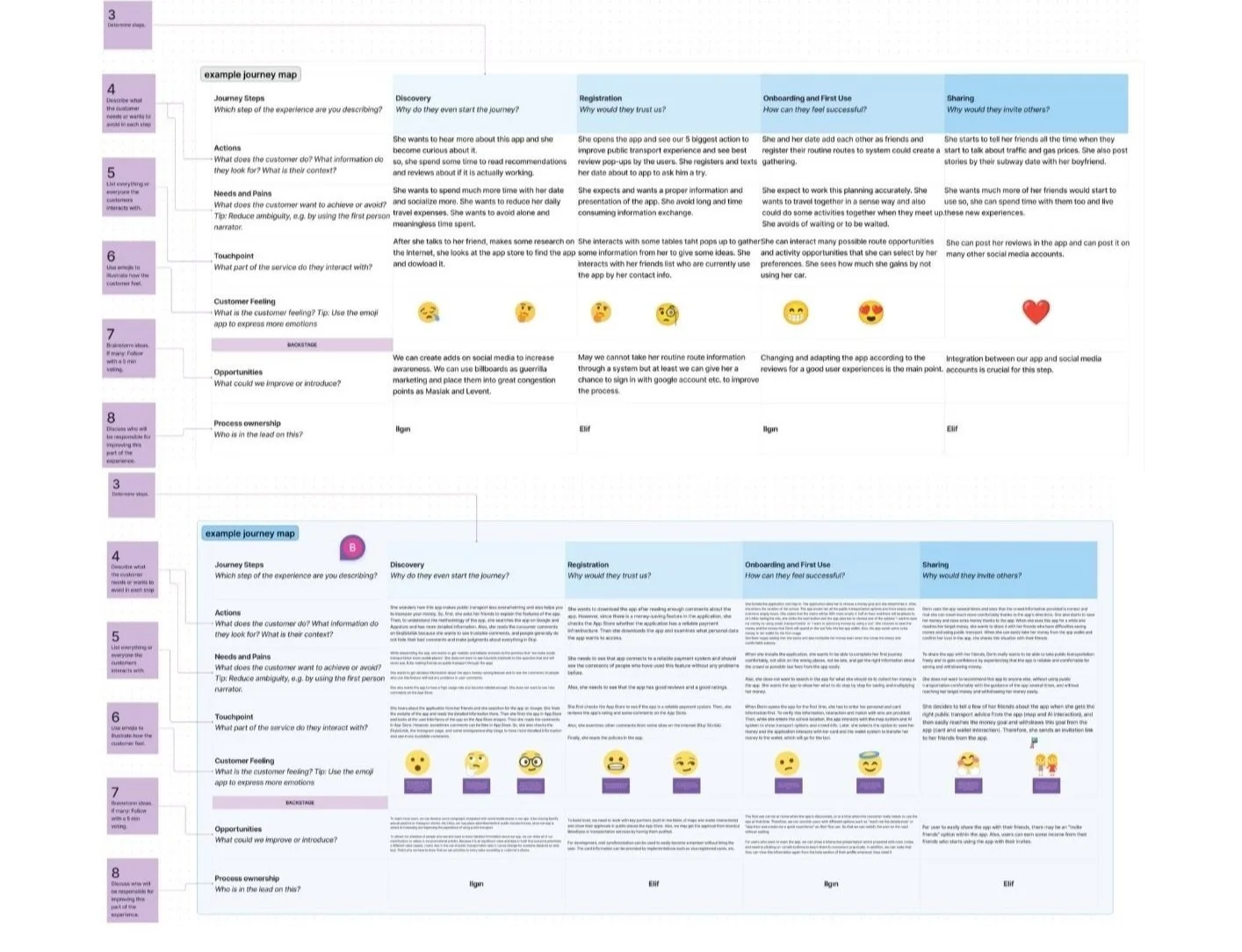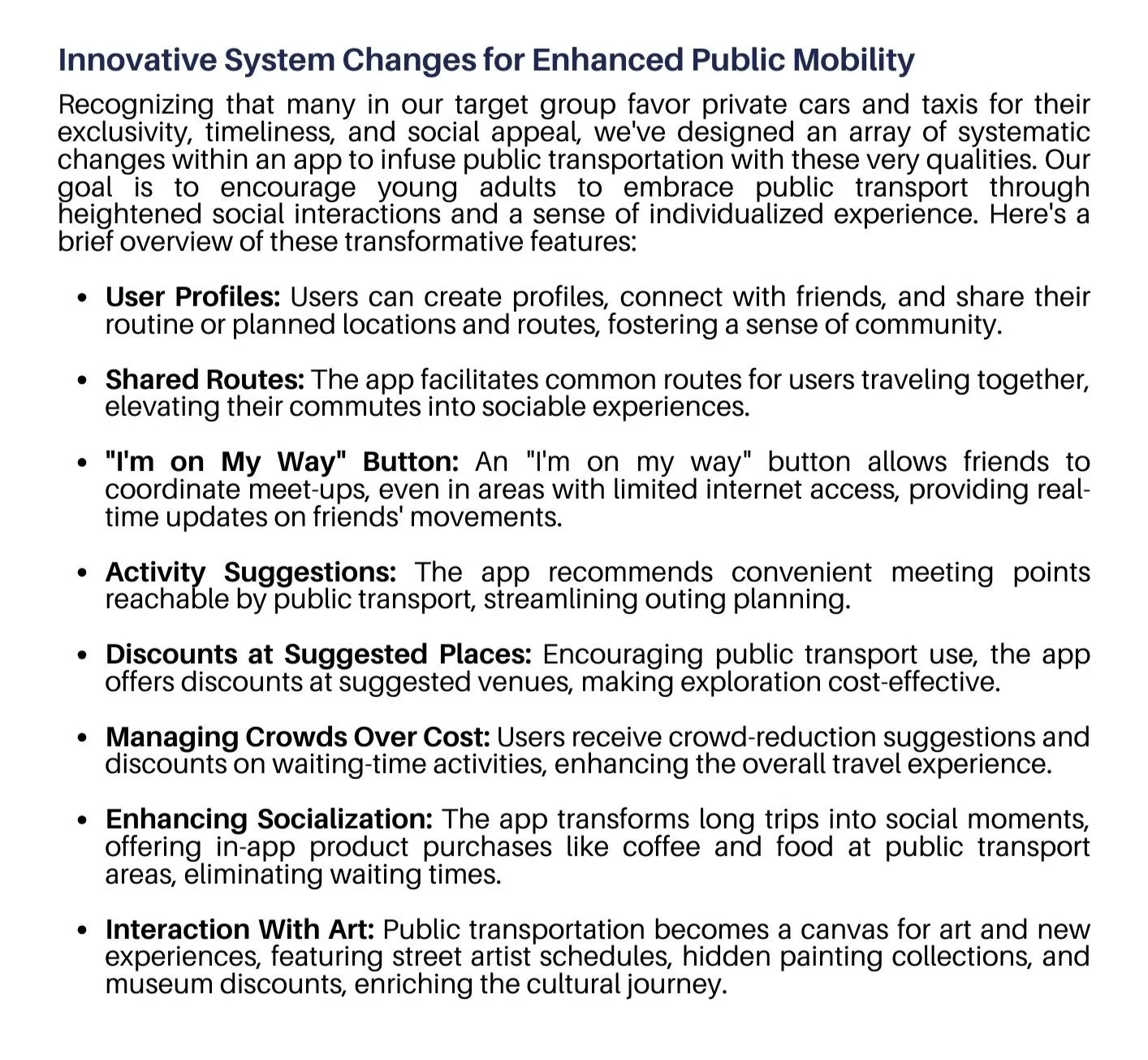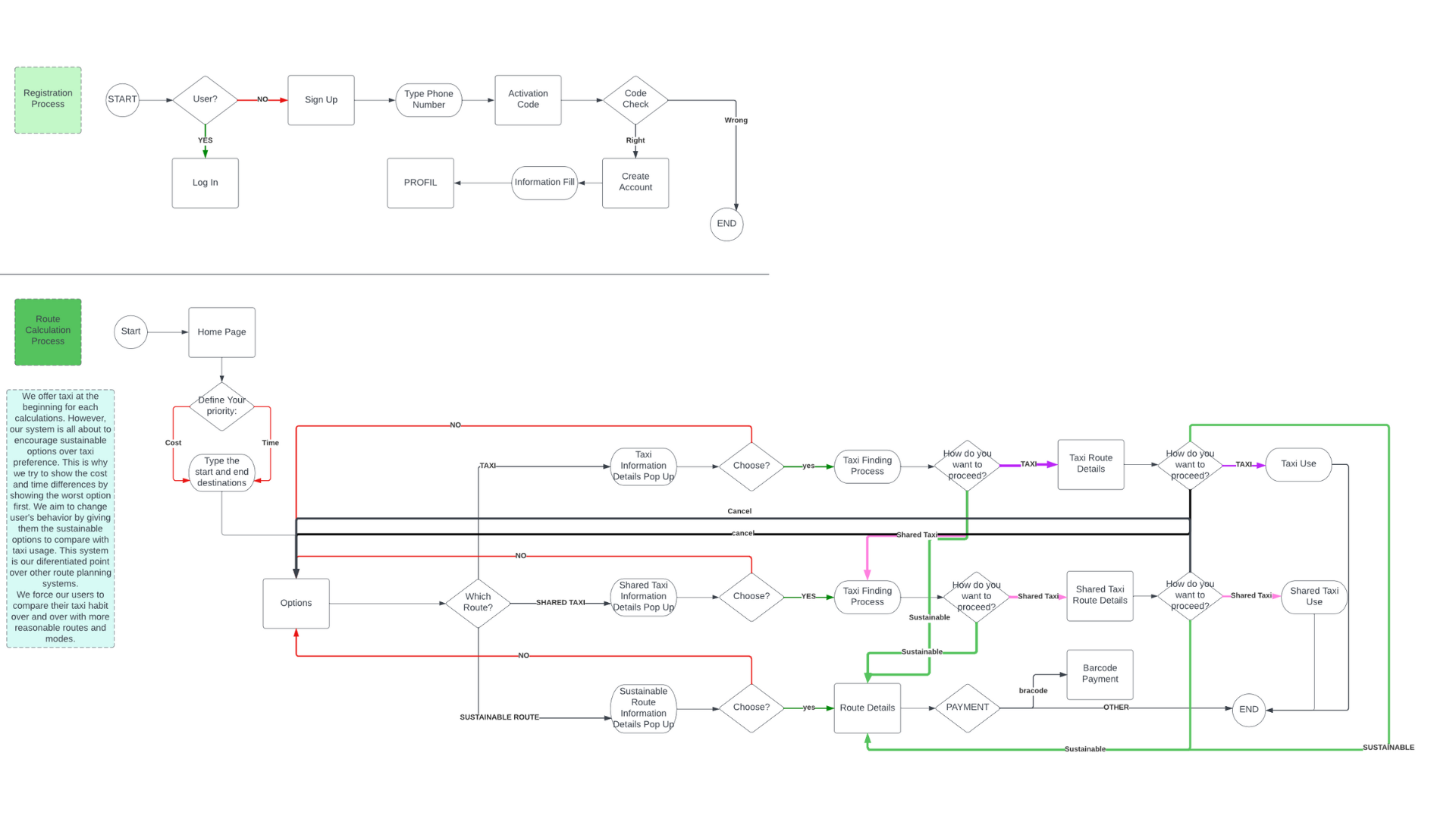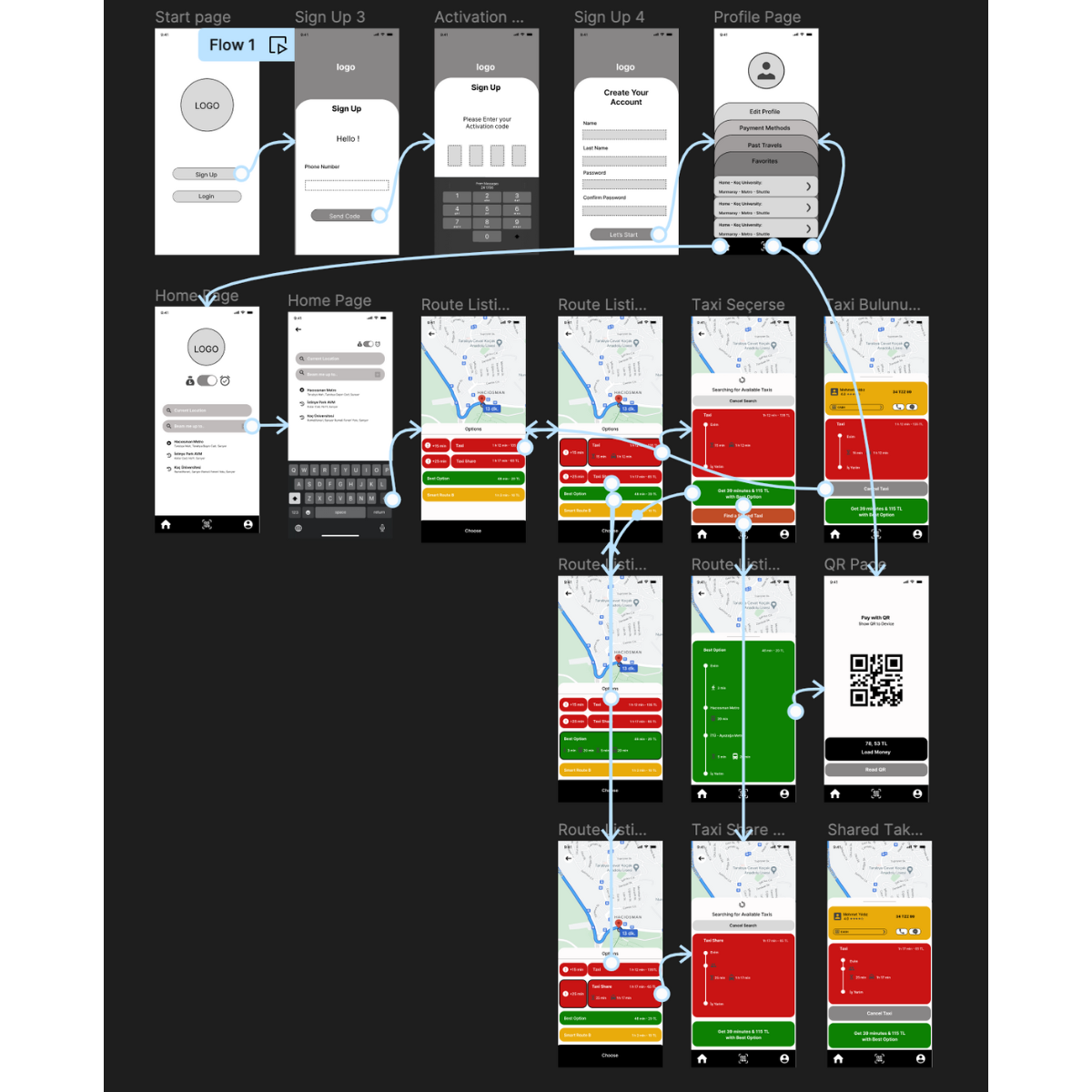BeamUp!
UX Research Process
Duration: 10 Weeks
Our journey to pinpoint a critical problem within Istanbul's complex mobility landscape led us to a pressing concern. Despite the existence of diverse alternative transportation options, there remains a significant reluctance to shift from private automobiles to public transport. This observation became a pivotal moment in our research journey, prompting us to choose "Public Mobility First" as our central problem area. Our aim is to tackle this challenge head-on by designing innovative solutions that prioritize public mobility and encourage a more sustainable, efficient, and accessible transportation ecosystem for Istanbul.
Collaborative Desk Research
Collaborative Stakeholder Analysis
In our quest to enhance Istanbul's transportation system, we conducted a comprehensive stakeholder analysis, categorizing individuals, organizations, and tools into three main groups. This analysis unveils the unique needs and priorities of these stakeholders, providing valuable insights to guide our mission of creating more sustainable, efficient, and accessible transportation solutions for Istanbul.
Mapping Stakeholder Relations
Before delving into the intricacies of our group work, we embarked on a collaborative effort to chart the complex web of relationships that bind our key stakeholders. With emotions like "hate" and "love" serving as indicators of sentiment, and factors like building, hiring, and employment status shaping the dynamics, our stakeholder relationship map offers a comprehensive view of the interplay between various stakeholders. This map is more than a network of connections; it's a dynamic representation of the emotions, influence, and interactions that underpin our mission to transform Istanbul's transportation landscape.
1st Ideation & Exploratory Research
The first project goal set at this stage was "Encourage people living in Istanbul to use sustainable public transportation and minimize the environmental, individual, and sociological problems created by individual mobility by making public mobility cleaner, more comfortable, reliable, accessible, and preferable with an integrated system "
The first target group was "People who live in Istanbul and do not prefer to use public transportation."
User Journey Mapping & First Project Goal
Problem Statement: Addressing public transport issues for 18-25-year-olds who primarily use cars and taxis, aiming to reduce time, costs, and solo commutes due to system deficiencies.
Target Audience: Focusing on young adults aged 18-25 who switched from public transport to cars or taxis due to dissatisfaction and a perceived lack of alternatives.
Importance of Solving: Crucial due to the younger generation's awareness of the inefficiency and burdens of their current transportation choices, with the potential to set an example for future habits.
Proposed Solution: Enhancing rail systems to reduce car use in metro and Marmaray-adjacent areas, transforming stops into social hubs, and introducing an app to provide cost comparisons, route data, and social features for public transport.
Preliminary Jury & Results
During the initial jury assessment, it was determined that the concept of utilizing public transportation as social hubs may not yield a substantial shift in the behavior of taxi users, private car owners or any young adults who are not used to choose public transportation.
2nd Ideation & Revised Design Goal
-
In response to preliminary jury evaluations, we adapted our design goal and app concept to better align with the objective of behavior change.
-
Our extensive research unveiled crucial factors with the potential to significantly influence the behavior of taxi users.
-
These include the high cost of taxi fares, difficulties in locating available taxis, and the frequent issue of taxis being stuck in traffic.
-
To make public transportation more attractive, we aim to emphasize its advantages: speed, reduced waiting times, and cost-efficiency.
-
Our approach centers on presenting taxis in a less favorable light and highlighting the merits of public transportation. This approach is especially impactful within the domain where taxi users are most concentrated.
-
We've recognized that car owners often form strong attachments to their vehicles, viewing them as assets and expressions of social status. These deeply ingrained attachments pose a significant challenge in altering their transportation behavior, requiring a nuanced approach.
Hybrid App Concept
The new app concept takes the appearance of a conventional taxi app but strategically guides users away from taxis and towards public transportation options.
Comprehensive Coverage with Psychological Manipulation
We took a calculated risk, applying psychological principles like the anchor and recency effect to manipulate user behavior and decision-making processes. This involved providing the public transportation app in the guise of a taxi app, offering a familiar interface while subtly promoting public transport.
“This revised direction is aimed at guiding users toward making sustainable and cost-effective transportation choices while acknowledging the complexities of car owner attachments and behaviors.”
1st User Flow & Leveraging the Anchor Effect
In our app's user flow, we strategically present the taxi alternative as the primary option in all route calculations, capitalizing on the anchor effect—a psychological bias in decision-making. By consistently highlighting the taxi option, we create a reference point against which all other alternatives are compared.
Notably, in the bustling city of Istanbul, taxis and congestion often prove to be the least optimal choice for transportation. Capitalizing on this knowledge, we introduce the best alternative immediately after the taxi— one that is not only the most sustainable but also highly cost-effective and budget-friendly.
This design approach aims to trigger users by prominently demonstrating the substantial differences in terms of money, time, and environmental savings. By providing a clear and compelling contrast, we encourage users to make more informed and sustainable transportation choices.
This innovative approach sets us apart from other route planning apps in the sector. We differentiate ourselves by offering all transportation options, including taxis, and then effectively guiding users toward more eco-friendly choices, a strategy that enhances download rates and boosts the app's appeal.
Wireframe +
1st Design & Prototyping
Evaluative Research
Research Approach
For our evaluative user research, we employed the User Testing method. Participants were tasked with performing six different actions using our mobile app prototype. Observations were made during each task, and participants were questioned about their experiences, highlighting exciting, boring, clear, and confusing aspects of the app's user interface and flow. Additionally, semi-structured interviews were conducted with participants during and after the user testing, evaluating the app's usability and gathering their feedback on its idea, flow, and visual aspects.
Our interviews involved ten university students aged 20-25 residing in Istanbul who primarily use taxis over public transportation due to not owning a car. These participants were aligned with our target demographic, prioritizing taxis as their transportation mode.
Research Findings
All participants were able to complete tasks easily.
Participants readily noticed money/time differentials in the filtering section.
Sustainable and smart routes under the taxi option were easily identified.
The "Beam me up!" expression was widely liked for its association with speed and joy.
"Best Option" in green grabbed immediate attention on the options page.
Participants considered changing their choice after comparing the best option with taxis.
The app was perceived as unique when compared to Moovit and BiTaksi.
Past trip information was easily accessible.
Research Findings
60% of participants requested expanding the filtering section, including safety and step-free transport options.
60% struggled to understand the taxi waiting information box and its purpose.
40% found it unclear why the taxi option ranked at the top.
70% initially favored the "Best Route" while 30% chose it after waiting for a taxi.
80% had difficulty with the QR model of the payment section.
50% suggested including BinBin/Martı scooters in the application.
A participant proposed visually equalizing the taxi option on the taxi waiting page.
60% faced challenges understanding the phrase "Get..." on the taxi waiting page.
30% believed a more general home page would be interesting.
Participants found the app innovative and inclusive but encountered minor issues with details. They welcomed the filter option and desired a cheerful visual design.
Revision Plan
In response to the evaluation, we outlined the following improvements for the application:
Incorporate cheerful expressions and visuals based on the participants' positive response to "Beam me up!"
Enhance the filtering page with additional filtering options (e.g., security, step-free options).
Visually redesign the taxi and taxi share waiting time box for better clarity.
Visually separate the taxi and public transport options to clarify their distinct presentation and prevent internal comparisons.


